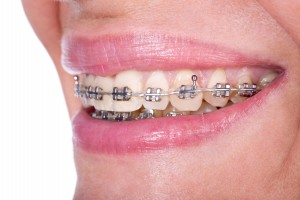It may seem surprising, but it’s actually quite rare to have perfectly straight and aligned teeth. Most people have some kind of malocclusion, or an imperfect positioning of the teeth, though it’s usually minor enough that it doesn’t warrant intervention. That being said, there are (unfortunately!) a lot of ways for the teeth to grown crooked or for the jaw to be misaligned, which can be genetic but also has a lot to do with how the teeth develop during childhood. Early loss of baby teeth, thumb sucking, and missing teeth can all have an effect on the development of the jaw and adult teeth. Let’s take a look at the four broad categories of malocclusion, and what the issues — and solution — are for each.
Crossbite
A crossbite is when a single or group of upper teeth bite on the inside of the lower teeth. Crossbites are different from overbites and underbites because it affects only a portion of the teeth, either on the sides (buccal) or in the front (lingual).
Crossbites tend to be a genetic condition but they can also occur due to uneven development of the jaw, as well as digit sucking or early loss of baby teeth. A crossbite puts excess stress on the jawbone and can also cause the affected teeth to wear down more easily. This can make it difficult to chew and can affect your smile, especially if the front teeth are affected. Most commonly this condition is corrected using braces and/or a palate expander.
Open bite
An open bite occurs when the front teeth just out in such a way that when the mouth is closed, there is a visible gap between the teeth. This is a very common occurrence in children who suck their thumb or another digit, as well as people who have tongue thrust — you can learn more about that condition here.
Both of these issues put forward pressure on the front top and bottom teeth, making them jut outwards. This not only very visually apparent, it also puts a lot of strain on the back teeth and can cause them to wear down quickly. Open bites also put a strain on the jaw and the jaw joint, making it painful to chew and open and close the mouth. And, while this condition can be corrected with braces, it’s extremely important to also stop the digit sucking or tongue thrust behavior, which will cause the condition to reoccur after it’s fixed. You certainly aren’t going to want to go through braces twice!
Overbite
The most common malocclusion, the overbite is when the upper teeth protrude over the lower teeth. Now, the upper teeth are supposed to sit forwards of the lower teeth, but it becomes a malocclusion when the lower teeth are being pushed back or if the upper teeth are coming out too far. This condition is also called “deep bite” or “overset” teeth.
Overbites occur when the upper front teeth erupt too far or when the jaw and bone behind the teeth over-develop, which is often genetic. This condition can make it difficult to chew and can also irritate the gums and upper palate, as the lower teeth can sometimes push into these areas. An overbite can most commonly be corrected using braces, though in severe cases the jaw may need to be surgically repositioned to alleviate pressure and to prevent the lower teeth from hitting the upper palate.
Underbite
An underbite occurs when the lower teeth protrude over the front teeth. This is usually caused by the underdevelopment of the upper jaw or the overgrowth of the lower jaw — or even a combination of the two. An underbite makes it hard for both the front and the back teeth to function, making it difficult to chew. It’s also a condition that is very apparent when smiling, which makes many people self-conscious. As with an overbite, an underbite is commonly corrected with braces, but surgical intervention or even the removal of teeth may be necessary to fix the positioning of the jaw and alleviate any dental crowding that may have developed.
Although a visual inspection of the teeth is important in diagnosing malocclusions, x-rays are also essential to understanding how the condition is affecting the underlying bone structure and the roots of the teeth. Although your dentist may make the primary diagnosis, an orthodontist is a specialist who deals with bite and alignment issues and will be the one who dictates how the issues should be resolved. As we said above, braces are the most common solution to most bite and jaw issues, though palate expanders and retainers can also be used before or after braces. In rarer cases where the teeth are severely crowded due to a malocclusion, your orthodontist may opt to remove teeth to make it easier to bring your overall set into better alignment. Surgery may also be necessary to fix severe jaw issues, but again, this tends to be rare.
Malocclusions that develop in childhood should be treated as early as possible, as they are generally easier to correct and encourages a healthy set of adult teeth and less dental problems throughout the years. Regardless of when your malocclusion develops, they’re important to fix because of how severely they can impact your ability to chew, swallow, or even breathe. The excess strain they put on your teeth and jaw can be very damaging over time, leading to tooth and bone loss in extreme cases. Plus, malocclusions tend to be very visually apparent, which can make people very self-conscious about their smile. Nobody should ever have to be afraid to smile, so do yourself a favor and take the first step towards getting those teeth in tip top shape. How so? Drop us a line right here!








Leave a Reply